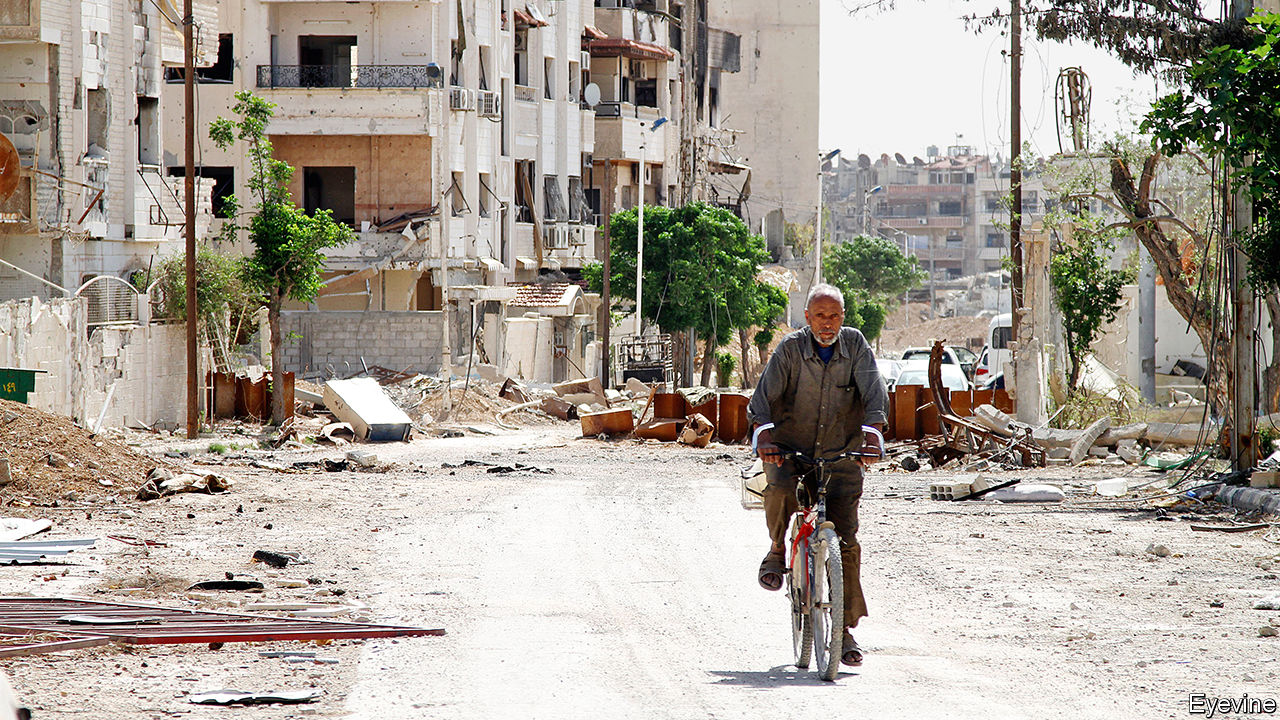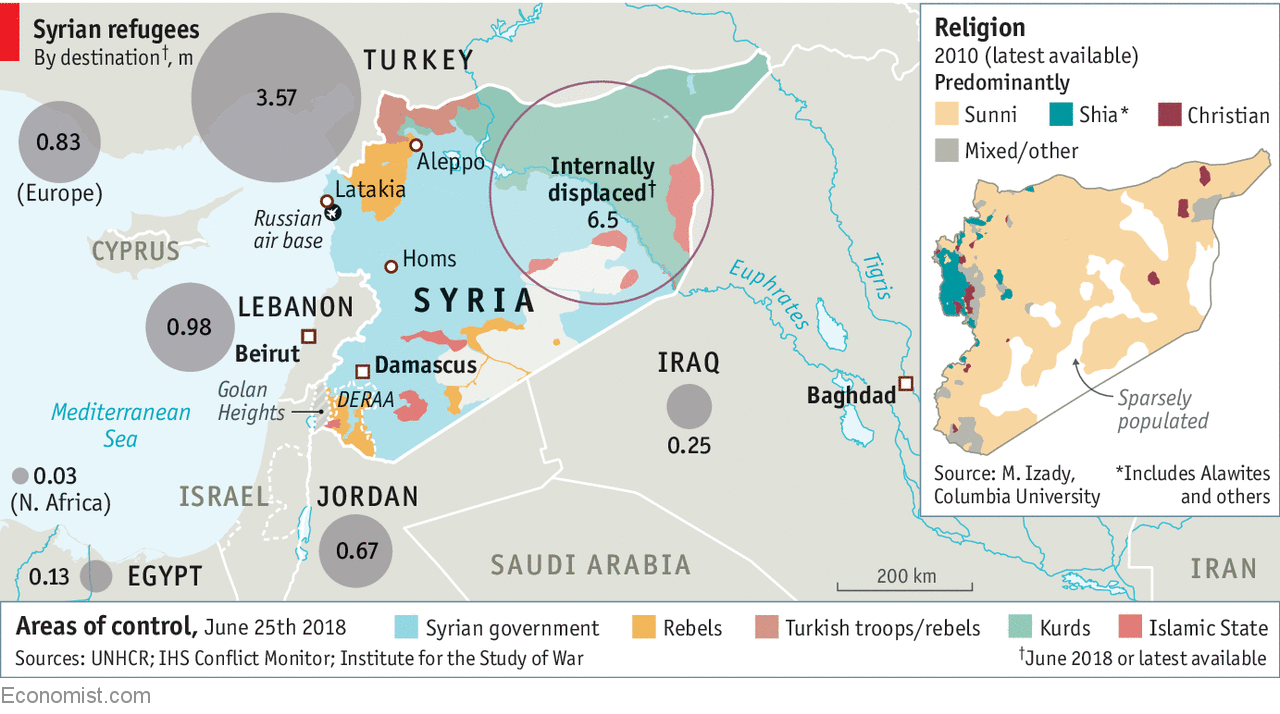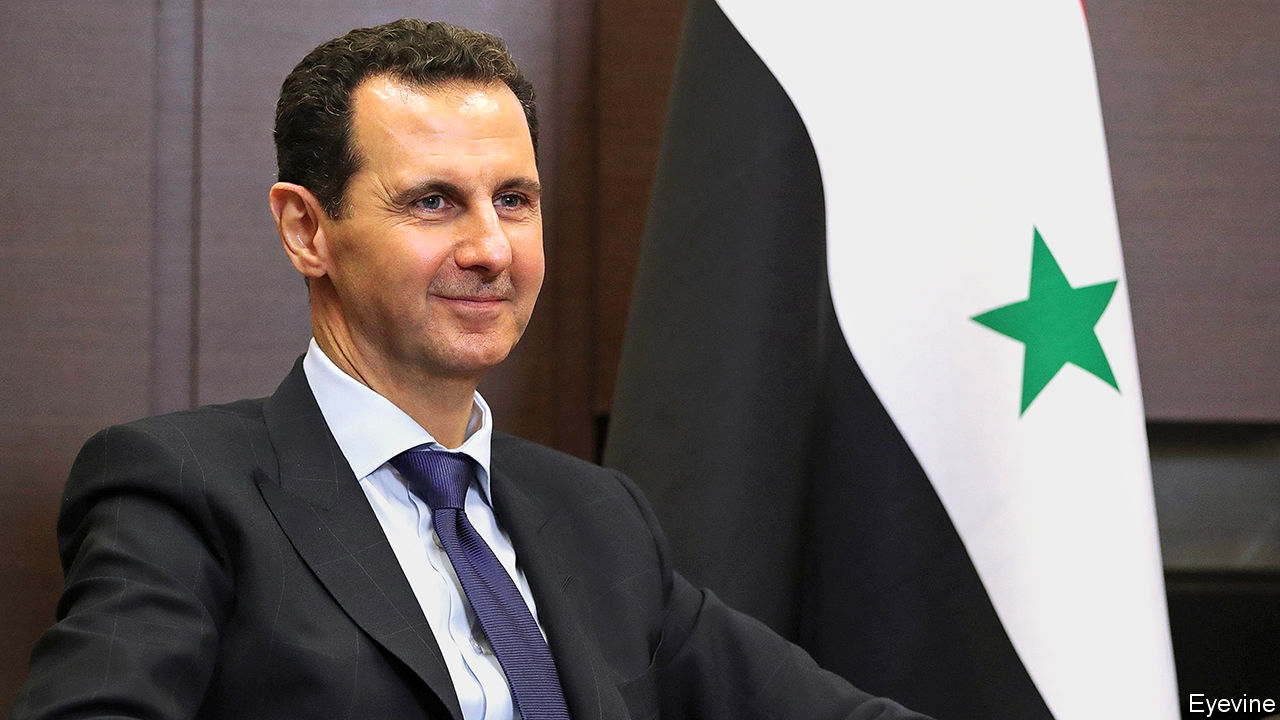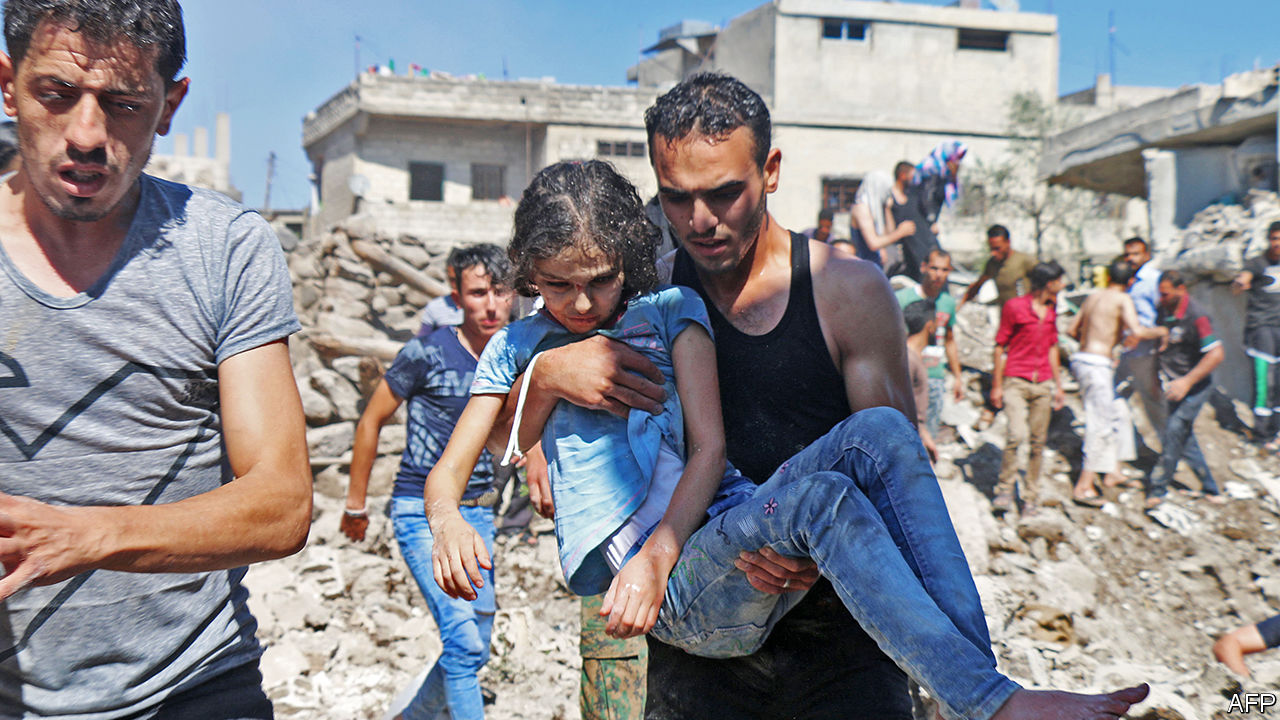 A NEW Syria is emerging from the rubble of war. In Homs, which Syrians once dubbed the “capital of the revolution” against President Bashar al-Assad, the Muslim quarter and commercial district still lie in ruins, but the Christian quarter is reviving. Churches have been lavishly restored; a large crucifix hangs over the main street. “Groom of Heaven”, proclaims a billboard featuring a photo of a Christian soldier killed in the seven-year conflict. In their sermons, Orthodox patriarchs praise Mr Assad for saving one of the world’s oldest Christian communities.
A NEW Syria is emerging from the rubble of war. In Homs, which Syrians once dubbed the “capital of the revolution” against President Bashar al-Assad, the Muslim quarter and commercial district still lie in ruins, but the Christian quarter is reviving. Churches have been lavishly restored; a large crucifix hangs over the main street. “Groom of Heaven”, proclaims a billboard featuring a photo of a Christian soldier killed in the seven-year conflict. In their sermons, Orthodox patriarchs praise Mr Assad for saving one of the world’s oldest Christian communities.
Homs, like all of the cities recaptured by the government, now belongs mostly to Syria’s victorious minorities: Christians, Shias and Alawites (an esoteric offshoot of Shia Islam from which Mr Assad hails). These groups banded together against the rebels, who are nearly all Sunni, and chased them out of the cities. Sunni civilians, once a large majority, followed. More than half of the country’s population of 22m has been displaced—6.5m inside Syria and over 6m abroad. Most are Sunnis.
The authorities seem intent on maintaining the new demography. Four years after the government regained Homs, residents still need a security clearance to return and rebuild their homes. Few Sunnis get one. Those that do have little money to restart their lives. Some attend Christian mass, hoping for charity or a visa to the West from bishops with foreign connections. Even these Sunnis fall under suspicion. “We lived so well before,” says a Christian teacher in Homs. “But how can you live with a neighbour who overnight called you a kafir (infidel)?”
Even in areas less touched by the war, Syria is changing. The old city of Damascus, Syria’s capital, is an architectural testament to Sunni Islam. But the Iranian-backed Shia militias that fight for Mr Assad have expanded the city’s Shia quarter into Sunni and Jewish areas. Portraits of Hassan Nasrallah, the leader of Hizbullah, a Lebanese Shia militia, hang from Sunni mosques. Advertisements for Shia pilgrimages line the walls. In the capital’s new cafés revellers barely notice the jets overhead, bombing rebel-held suburbs. “I love those sounds,” says a Christian woman who works for the UN. Like other regime loyalists, she wants to see the “terrorists” punished.
Mr Assad’s men captured the last rebel strongholds around Damascus in May. He now controls Syria’s spine, from Aleppo in the north to Damascus in the south—what French colonisers once called la Syrie utile (useful Syria). The rebels are confined to pockets along the southern and northern borders (see map). Lately the government has attacked them in the south-western province of Deraa.

A prize of ruins
The regime is in a celebratory mood. Though thinly spread, it has survived the war largely intact. Government departments are functioning. In areas that remained under Mr Assad’s control, electricity and water supplies are more reliable than in much of the Middle East. Officials predict that next year’s natural-gas production will surpass pre-war levels. The National Museum in Damascus, which locked up its prized antiquities for protection, is preparing to reopen to the public. The railway from Damascus to Aleppo might resume operations this summer.
To mark national day on April 17th, the ancient citadel of Aleppo hosted a festival for the first time since the war began. Martial bands, dancing girls, children’s choirs and a Swiss opera singer (of Syrian origin) crowded onto the stage. “God, Syria and Bashar alone,” roared the flag-waving crowd, as video screens showed the battle to retake the city. Below the citadel, the ruins stretch to the horizon.
 Bashar the destroyerMr Assad (pictured) has been winning the war by garrisoning city centres, then shooting outward into rebel-held suburbs. On the highway from Damascus to Aleppo, towns and villages lie desolate. A new stratum of dead cities has joined the ones from Roman times. The regime has neither the money nor the manpower to rebuild. Before the war Syria’s economic growth approached double digits and annual GDP was $60bn. Now the economy is shrinking; GDP was $12bn last year. Estimates of the cost of reconstruction run to $250bn.
Bashar the destroyerMr Assad (pictured) has been winning the war by garrisoning city centres, then shooting outward into rebel-held suburbs. On the highway from Damascus to Aleppo, towns and villages lie desolate. A new stratum of dead cities has joined the ones from Roman times. The regime has neither the money nor the manpower to rebuild. Before the war Syria’s economic growth approached double digits and annual GDP was $60bn. Now the economy is shrinking; GDP was $12bn last year. Estimates of the cost of reconstruction run to $250bn.
Syrians are experienced construction workers. When Lebanon’s civil war ended in 1990, they helped rebuild Beirut. But no such workforce is available today. In Damascus University’s civil-engineering department, two-thirds of the lecturers have fled. “The best were first to go,” says one who stayed behind. Students followed them. Those that remain have taken to speaking Araglish, a hotch-potch of Arabic and English, as many plan futures abroad.
Traffic flows lightly along once-jammed roads in Aleppo, despite the checkpoints. Its pre-war population of 3.2m has shrunk to under 2m. Other cities have also emptied out. Men left first, many fleeing the draft and their likely dispatch to the front. As in Europe after the first world war, Syria’s workforce is now dominated by women. They account for over three-quarters of the staff in the religious-affairs ministry, a hitherto male preserve, says the minister. There are female plumbers, taxi-drivers and bartenders.
Millions of Syrians who stayed behind have been maimed or traumatised. Almost everyone your correspondent spoke to had buried a close relative. Psychologists warn of societal breakdown. As the war separates families, divorce rates soar. More children are begging in the streets. When the jihadists retreat, liquor stores are the first to reopen.
Mr Assad, though, seems focused less on recovery than rewarding loyalists with property left behind by Sunnis. He has distributed thousands of empty homes to Shia militiamen. “Terrorists should forfeit their assets,” says a Christian businesswoman, who was given a plush café that belonged to the family of a Sunni defector. A new decree, called Law 10, legitimises the government’s seizure of such assets. Title-holders will forfeit their property if they fail to re-register it, a tough task for the millions who have fled the country.
A Palestinian-like problem
The measure has yet to be implemented, but refugees compare it to Israel’s absentees’ property laws, which allow the government to take the property of Palestinian refugees. Syrian officials, of course, bridle at such comparisons. The ruling Baath party claims to represent all of Syria’s religions and sects. The country has been led by Alawites since 1966, but Sunnis held senior positions in government, the armed forces and business. Even today many Sunnis prefer Mr Assad’s secular rule to that of Islamist rebels.
But since pro-democracy protests erupted in March 2011, Syrians detect a more sectarian approach to policymaking. The first demonstrations attracted hundreds of thousands of people of different faiths. So the regime stoked sectarian tensions to divide the opposition. Sunnis, it warned, really wanted winner-take-all majoritarianism. Jihadists were released from prison in order to taint the uprising. As the government turned violent, so did the protesters. Sunni states, such as Turkey, Saudi Arabia and Qatar, provided them with arms, cash and preachers. Hardliners pushed aside moderates. By the end of 2011, the protests had degenerated into a sectarian civil war.
Early on, minorities lowered their profile to avoid being targeted. Women donned headscarves. Non-Muslim businessmen bowed to demands from Sunni employees for prayer rooms. But as the war swung their way, minorities regained their confidence. Alawite soldiers now flex arms tattooed with Imam Ali, whom they consider the first imam after the Prophet Muhammad (Sunnis see things differently). Christian women in Aleppo show their cleavage. “We would never ask about someone’s religion,” says an official in Damascus. “Sorry to say, we now do.”
The country’s chief mufti is a Sunni, but there are fewer Sunnis serving in top posts since the revolution. Last summer Mr Assad replaced the Sunni speaker of parliament with a Christian. In January he broke with tradition by appointing an Alawite, instead of a Sunni, as defence minister.
Officially the government welcomes the return of displaced Syrians, regardless of their religion or sect. “Those whose hands are not stained with blood will be forgiven,” says a Sunni minister. Around 21,000 families have returned to Homs in the last two years, according to its governor, Talal al-Barazi. But across the country, the number of displaced Syrians is rising. Already this year 920,000 people have left their homes, says the UN. Another 45,000 have fled the recent fighting in Deraa. Millions more may follow if the regime tries to retake other rebel enclaves.
When the regime took Ghouta, in eastern Damascus, earlier this year its 400,000 residents were given a choice between leaving for rebel-held areas in the north or accepting a government offer of shelter. The latter was a euphemism for internment. Tens of thousands remain “captured” in camps, says the UN. “We swapped a large prison for a smaller one,” says Hamdan, who lives with his family in a camp in Adra, on the edge of Ghouta. They sleep under a tarpaulin in a schoolyard with two other families. Armed guards stand at the gates, penning more than 5,000 people inside.
The head of the camp, a Christian officer, says inmates can leave once their security clearance is processed, but he does not know how long that will take. Returning home requires a second vetting. Trapped and powerless, Hamdan worries that the regime or its supporters will steal his harvest—and then his land. Refugees fear that they will be locked out of their homeland altogether. “We’re the new Palestinians,” says Taher Qabar, one of 350,000 Syrians camped in Lebanon’s Bekaa Valley.
Some argue that Mr Assad, with fewer Sunnis to fear, may relax his repressive rule. Ministers in Damascus insist that change is inevitable. They point to a change in the constitution made in 2012 that nominally allows for multiparty politics. There are a few hopeful signs. Local associations, once banned, offer vocational training to the displaced. State media remain Orwellian, but the internet is unrestricted and social-media apps allow for unfettered communication. Students in cafés openly criticise the regime. Why doesn’t Mr Assad send his son, Hafez, to the front, sneers a student who has failed his university exams to prolong his studies and avoid conscription.
A decade ago Mr Assad toyed with infitah (liberalisation), only for Sunni extremists to build huge mosques from which to spout their hate-speech, say his advisers. He is loth to repeat the mistake. Portraits of the president, appearing to listen keenly with a slightly oversized ear, now line Syria’s roads and hang in most offices and shops. Checkpoints, introduced as a counter-insurgency measure, control movement as never before. Men under the age of 42 are told to hand over cash or be sent to the front. So rife are the levies that diplomats speak of a “checkpoint economy”.
Having resisted pressure to compromise when he was losing, Mr Assad sees no reason to make concessions now. He has torpedoed proposals for a political process, promoted by UN mediators and his Russian allies, that would include the Sunni opposition. At talks in Sochi in January he diluted plans for a constitutional committee, insisting that it be only consultative and based in Damascus. His advisers use the buzzwords of “reconciliation” and “amnesty” as euphemisms for surrender and security checks. He has yet to outline a plan for reconstruction.
War, who is it good for?
Mr Assad appears to be growing tired of his allies. Iran has resisted Russia’s call for foreign forces to leave Syria. It refuses to relinquish command of 80,000 foreign Shia militiamen. Skirmishes between the militias and Syrian troops have resulted in scores of deaths, according to researchers at King’s College in London. Having defeated Sunni Islamists, army officers say they have no wish to succumb to Shia ones. Alawites, in particular, flinch at Shia evangelising. “We don’t pray, don’t fast [during Ramadan] and drink alcohol,” says one.
 Are they the next to leave?But Mr Assad still needs his backers. Though he rules most of the population, about 40% of Syria’s territory lies beyond his control. Foreign powers dominate the border areas, blocking trade corridors and the regime’s access to oilfields. In the north-west, Turkish forces provide some protection for Hayat Tahrir al-Sham, a group linked to al-Qaeda, and other Sunni rebels. American and French officers oversee a Kurdish-led force east of the Euphrates river. Sunni rebels abutting the Golan Heights offer Israel and Jordan a buffer. In theory the territory is classified as a “de-escalation zone”. But violence in the zone is escalating again.
Are they the next to leave?But Mr Assad still needs his backers. Though he rules most of the population, about 40% of Syria’s territory lies beyond his control. Foreign powers dominate the border areas, blocking trade corridors and the regime’s access to oilfields. In the north-west, Turkish forces provide some protection for Hayat Tahrir al-Sham, a group linked to al-Qaeda, and other Sunni rebels. American and French officers oversee a Kurdish-led force east of the Euphrates river. Sunni rebels abutting the Golan Heights offer Israel and Jordan a buffer. In theory the territory is classified as a “de-escalation zone”. But violence in the zone is escalating again.
New offensives by the regime risk pulling foreign powers deeper into the conflict. Turkey, Israel and America have drawn red lines around the rebels under their protection. Continuing Iranian operations in Syria “would be the end of [Mr Assad], his regime”, said Yuval Steinitz, a minister in Israel, which has bombed Iranian bases in the country. Israel may be giving the regime a green light in Deraa, in order to keep the Iranians out of the area.
There could be worse options than war for Mr Assad. More fighting would create fresh opportunities to reward loyalists and tilt Syria’s demography to his liking. Neighbours, such as Jordan and Lebanon, and European countries might indulge the dictator rather than face a fresh wave of refugees. Above all, war delays the day Mr Assad has to face the question of how he plans to rebuild the country that he has so wantonly destroyed.
No comments:
Post a Comment